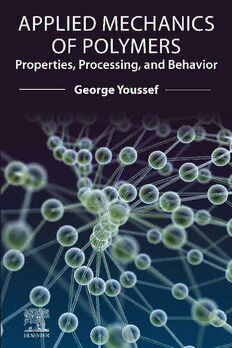Table Of ContentApplied Mechanics of Polymers
Applied Mechanics
of Polymers
Properties, Processing, and Behavior
George Youssef
San DiegoStateUniversity, SanDiego,CA, USA
Elsevier
Radarweg29,POBox211,1000AEAmsterdam,Netherlands
TheBoulevard,LangfordLane,Kidlington,OxfordOX51GB,UnitedKingdom
50HampshireStreet,5thFloor,Cambridge,MA02139,UnitedStates
Copyright©2022ElsevierInc.Allrightsreserved.
Nopartofthispublicationmaybereproducedortransmittedinanyformorbyanymeans,
electronicormechanical,includingphotocopying,recording,oranyinformationstorageand
retrievalsystem,withoutpermissioninwritingfromthepublisher.Detailsonhowtoseek
permission,furtherinformationaboutthePublisher’spermissionspoliciesandourarrangements
withorganizationssuchastheCopyrightClearanceCenterandtheCopyrightLicensingAgency,can
befoundatourwebsite:www.elsevier.com/permissions.
Thisbookandtheindividualcontributionscontainedinitareprotectedundercopyrightbythe
Publisher(otherthanasmaybenotedherein).
Notices
Knowledgeandbestpracticeinthisfieldareconstantlychanging.Asnewresearchandexperience
broadenourunderstanding,changesinresearchmethods,professionalpractices,ormedical
treatmentmaybecomenecessary.
Practitionersandresearchersmustalwaysrelyontheirownexperienceandknowledgeinevaluating
andusinganyinformation,methods,compounds,orexperimentsdescribedherein.Inusingsuch
informationormethodstheyshouldbemindfuloftheirownsafetyandthesafetyofothers,
includingpartiesforwhomtheyhaveaprofessionalresponsibility.
Tothefullestextentofthelaw,neitherthePublishernortheauthors,contributors,oreditors,
assumeanyliabilityforanyinjuryand/ordamagetopersonsorpropertyasamatterofproducts
liability,negligenceorotherwise,orfromanyuseoroperationofanymethods,products,
instructions,orideascontainedinthematerialherein.
LibraryofCongressCataloging-in-PublicationData
AcatalogrecordforthisbookisavailablefromtheLibraryofCongress
BritishLibraryCataloguing-in-PublicationData
AcataloguerecordforthisbookisavailablefromtheBritishLibrary
ISBN:978-0-12-821078-9
ForinformationonallElsevierpublications
visitourwebsiteathttps://www.elsevier.com/books-and-journals
Publisher:MatthewDeans
AcquisitionsEditor:DennisMcGonagle
EditorialProjectManager:VeronicaSantosIII
ProductionProjectManager:DebasishGhosh
CoverDesigner:VictoriaPearson
TypesetbySTRAIVE,India
Contents
1. Introduction and background 1
1.1 Introduction 1
1.2 Historicalperspective 6
1.3 Typeofpolymers 8
1.4 Areasofstudyinpolymerscience 12
1.4.1 Polymerchemistry 13
1.4.2 Polymerphysics 15
1.4.3 Polymermechanics 15
1.5 Industrialapplicationsofpolymers 16
1.6 Closingremarks 17
Practiceproblems 17
References 18
2. General properties of polymers 19
2.1 Introduction 19
2.2 Quasi-staticmechanicalresponse 24
2.3 Long-termproperties 33
2.3.1 Creep 33
2.3.2 Relaxation 38
2.4 Dynamicproperties 39
2.5 Otherproperties 45
Practiceproblems 45
References 47
3. Processing and manufacturing of polymers 49
3.1 Introduction 49
3.2 Extrusion 56
3.3 Sheets,films,andfilaments 60
3.4 Thermoforming 63
3.5 Injectionmolding 66
3.6 Additivemanufacturing 69
Practiceproblems 75
References 76
v
vi Contents
4. Linear elastic behavior of polymers 79
4.1 Introduction 79
4.2 Stressandequilibrium 82
4.2.1 Planestress 90
4.2.2 Simpletension 91
4.2.3 Simpleshear 91
4.2.4 Hydrostaticstress 91
4.3 Strainandcompatibility 92
4.3.1 Planestrain 93
4.4 Linearelasticmaterialbehavior 94
4.4.1 Isotropicmaterials 94
4.4.2 Orthotropicmaterials 99
4.4.3 Transverseisotropicmaterials 100
4.5 Structuralcomponentdesign 101
4.6 AppliedFEAsimulationexamples 108
Practiceproblems 115
References 116
5. Hyperelastic behavior of polymers 117
5.1 Introduction 117
5.2 Theoreticalpreliminaries 118
5.2.1 Displacementfield 118
5.2.2 Deformationgradient 120
5.2.3 Polardecomposition 123
5.2.4 Straintensors 125
5.2.5 Stresstensors 126
5.3 Stress–strainrelationships 128
5.4 Hyperelasticmodels 132
5.4.1 Neo-Hookeanmodel 133
5.4.2 Mooney-Rivlinmodel 134
5.4.3 Yeohmodel 135
5.4.4 Gentmodel 136
5.4.5 Ogdenmodel 137
5.4.6 OgdenHyper-foammodel 138
5.5 Applicationsofhyperelasticmodelsincomponent
design 138
Practiceproblems 143
References 143
6. Creep behavior of polymers 145
6.1 Introduction 145
6.2 Simplecreepmodels 148
6.2.1 Maxwellmodel 150
6.2.2 Kelvinmodel 152
Contents vii
6.2.3 Four-parametersmodel 154
6.2.4 Zenermodel 156
6.3 Additionalcreepmodels 158
6.3.1 Findleypowerlaw 158
6.3.2 Norton–baileylaw 159
6.3.3 Prandtl–Garofalolaw 159
6.4 Applicationsofcreepincomponentdesign 160
6.5 AppliedFEAsimulationexample 160
Practiceproblems 162
References 164
7. Viscoelastic behavior of polymers 165
7.1 Introduction 165
7.2 Theoreticalpreliminaries 167
7.2.1 Boltzmannsuperpositionprinciple 167
7.2.2 GeneralizedMaxwellmodel 168
7.2.3 GeneralizedKelvinmodel 170
7.3 Linearviscoelasticity 171
7.3.1 Small-strainlinearviscoelasticity 172
7.3.2 Large-strainlinearviscoelasticity 185
7.4 Applicationsoflinearviscoelasticityincomponent
design 185
7.5 AppliedFEAsimulationexample 188
Practiceproblems 191
References 191
8. Electroactive polymers 193
8.1 Introduction 193
8.2 Theoreticalpreliminaries 195
8.3 Electrostrictivepolymers 204
8.4 Dielectricelastomers 207
8.5 Applicationsofelectroactivepolymers 214
8.6 AppliedFEAsimulationexample 215
Practiceproblems 217
References 218
9. Hydrogels 221
9.1 Introduction 221
9.2 Mechanicsofhydrogels 228
9.2.1 Hydrogeldeformationtheory 228
9.2.2 Poroelasticity 232
9.3 Applicationsofhydrogels 236
9.4 AppliedFEAsimulationexample 237
Practiceproblems 239
References 240
viii Contents
10. Failure and fracture of polymers 243
10.1 Introduction 243
10.2 Shearyielding 250
10.3 Crazing 254
10.4 Fracturemechanics 258
10.5 Fatigue 262
Practiceproblems 269
References 269
11. Characterization of polymers 273
11.1 Introduction 273
11.2 Thermalcharacterizations 278
11.2.1 Differentialscanningcalorimetry 278
11.2.2 Thermogravimetricanalyzer 281
11.3 Microscopycharacterizations 282
11.3.1 Opticalmicroscopy 284
11.3.2 Scanningelectronmicroscopy 285
11.3.3 Transmissionelectronmicroscopy 287
11.3.4 Atomicforcemicroscopy 287
11.4 Spectroscopycharacterizations 291
11.4.1 UV–visiblespectroscopy 292
11.4.2 Fouriertransforminfraredspectroscopy 293
11.4.3 Ramanspectroscopy 294
11.4.4 Terahertztime-domainspectroscopy 295
Practiceproblems 296
References 297
Index 301
Chapter 1
Introduction and background
1.1 Introduction
Polymers are one of the primary classes of materials rivaling metals and
ceramics while being an integral part of the remarkable and transformative
hybrid materials of polymer matrix composites. Polymers are commonly
referred to as plastics, but we ought to formalize this nomenclature since the
classification of polymers is important for the fundamental understanding of
their physicalpropertiesandmechanicalbehaviors,aswillbediscussedlater.
Polymersareubiquitousinmanyapplicationsrangingfromaerospacetoauto-
motive,fromconsumergoodstohouseholdgoods,andfromsportsgeartobio-
medical devices. In fact, we daily encounter polymers, intentionally or
unintentionally, in even some of the most mundane activities. For example,
anobservanteyewouldnoticepolymerseverywhereintheinteriorofanaircraft
assoonasyoustepinsidethefuselagecabin,wherethestructuralcabinwindow
systemandtheaccompanyingdustcoverthatweoftenareaskedtolowerdown
duringtakeoffandlanding,aremadeofdifferentpolymers.Anothercommon
transportation vehicle that encompasses a large percentage of polymers is the
passengerautomobile,whichhasnearly30%ofallitspartsmadeofdifferent
typesofpolymersdependingonthedesignrequirements.Thedashboard,instru-
mentpanel,interiortrim,seating,interlayerinthe frontandrear windshields,
andcarpetfibersarejustafewexamplesofinteriorpartsinthecarthataremade
ofpolymers.Manyautomotiveexteriorpartsarealsomadeofpolymerswhere
theyaresubjectedtoaggressiveloadingandenvironmentalconditionssuchas
the tires (being the most obvious), the bumpers, the undercarriage, the wheel
housing,theradiatorsupport,andthemanypartsinthefuelsystem,againjust
to list afew examples.
Evidentfromthediversityoftheapplicationsmentionedaboveisthebroad
rangeofoperatingandenvironmentalconditions.Polymersthatareusedunder
thehoodofacararerequiredtoendurecombinedthermalandmechanicalload-
ingforalongduration,whilethosethatareusedinthefuelsystemarerequired
toresistaggressivechemicals,e.g.,thefuel,whilesupportingaworkingpres-
sure of (cid:1)345kPa (mechanical loads). Moreover, some polymers have to bear
substantial mechanical loads while being abrasive resistant, e.g., tires help
AppliedMechanicsofPolymers.https://doi.org/10.1016/B978-0-12-821078-9.00011-9
Copyright©2022ElsevierInc.Allrightsreserved. 1
2 Appliedmechanicsofpolymers
supportasizableportionofthecarweight((cid:1)25%)whileenduringabrasiondur-
ing contact with the road. In all, the class of polymeric materials itself is as
diverseastheapplicationstheyareintegratedinto.Therefore, thegoalofthis
textbook is to provide the fundamental background to assist engineers in per-
forming meaningful stress analyses based on material constitutive models
derived fromthe theory ofcontinuummechanics.These materialmodelsrep-
resentanddescribethemechanicalbehaviorofthepolymerusedinthedesign.
With this background in mind, it is now fitting to briefly define polymers
notingthatthetermpolymeriscommonlyusedinterchangeablywiththeword
macromolecule,withinthepolymersciencecommunity.Thebasicdefinitionof
polymerscomesfromtheGreekrootsoftheword,wheretheoriginof‘poly’in
Greekiseither“polus’meaning“much’or‘polloi”meaning“many.”Polymers
are then materials of many repeating parts, units, or “mers” (from the Greek
word “meros”). Polymers are compounds consisting of repeating long-chain
unitsthatareconnected,whereeachsinglechainmayhavethousandsoreven
millionsoftherepeatingmers.Moreover,polymersarematerialswithinterdig-
itated molecules with different length scales. Generally, polymers are either
hydrocarbons (covalently-bonded carbon-hydrogen backbone) or silicones
(silicon-oxygenbackbone).Thismolecularstructureisresponsiblefortheover-
all properties of polymers. Polymers can either be natural (e.g., human DNA
and hair) or engineered (such as nylon and polyvinyl chloride). Some of the
overarchingadvantagesandlimitationsofpolymersaresuccinctlysummarized
inTable1.1,whichisnotintendedtobecomprehensiveorapplicablyinclusive
to all types of polymers. While time-dependent properties are included in the
tableasanexampleofgeneraldisadvantage,thismightbeadesirableattributes
for polymers used indynamic or impact situations.
Before delvingintomoredetails, therearethree questionsthatweneedto
ask and answer to not only motivate the whole field of study of polymer
mechanicsbutalsotogainaninsightfulperspectiveaboutthisinterestingclass
TABLE1.1 Generaladvantagesandlimitationsofengineeringpolymers.
Generaladvantages Generallimitations
Lowdensityrelativetometals LowYoung’smodulus(stiffness)
Goodstrength-to-weightratio Lowstrengthrelativetometals
Highcorrosionresistance Limited-servicetemperature
Lowelectricalandthermalconductivity Susceptibilitytoultravioletandother
radiation
Moisture,abrasion,andimpact Time-dependentproperties
resistance

